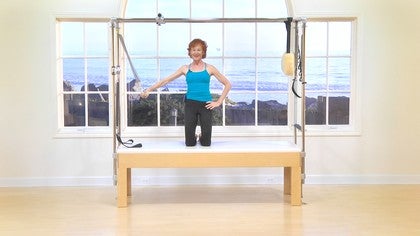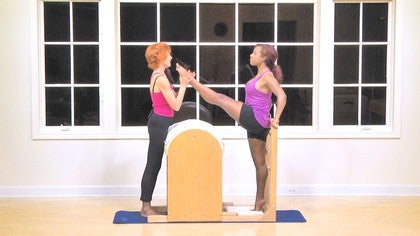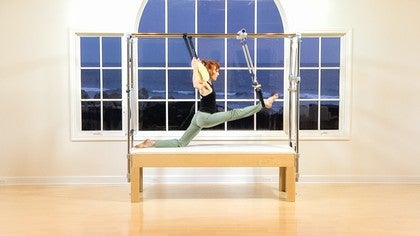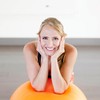Description
About This Video
Transcript
Read Full Transcript
Good afternoon everybody. Uh, today's session I will be focusing of course using the Cadillac, um, on our holistic workup, but with a lot of specific focus on the hips, on getting the it band to release a little bit more to stabilize the pelvis and Elongate the hamstrings as well as of course to have full workout altogether. So, um, I will start out as not as we so often do with lying down on my back. Is this a bit of a warmup for me for the hundreds with the roll down bar, lengthening the spine, just pressing the bar down in the direction of this a few
Because every machine, every piece of equipment is slightly different.
Again, breathing in and breathing out.
Rolling the hips up while I pop. Pull the bar down and lengthening the arms out. So from here, wrapping my knees over, I'm going to move down a bit so the arms are long. Whenever I press down I try to catch the skin. The trapezius muscles have a tendency to bunch up and pull forward.
I tried to press literally that skin down and checked in. My neck is always long. The elbows are lifted with the shoulders down and just a few times working down and up again to activate the hamstrings to activate that area right where the hamstrings connect into the glutes and keep a sense of a long steady pelvis and a pulled and long stomach. Then adding into this rolling stomach massage or rolling up through the spine, lengthening the hip flexors and then extending out, articulating through the spine all the way down, rolling in, lifting up, trying to get a little bit higher. Now lengthening out and again checking that beautiful section where the neck connects into the shoulders.
Is that skin staying back or am I rolling forward one more time like this right here. I engage the shoulders down my back and press down, rolling through, reversing it hips come up, bring the knees in and roll down and hips press ups who take a hand pressing through the sacrum to get the pelvis to lift. Hips come up and rolling through the spine to flat, taking the legs out, stretching the legs out. Just a few simple roll-ups, nothing connected. Just checking that the shoulders along, peeling my back off the mat, making sure that my waist is long as I stretch over just to start to wake up the spine, start to wake up the pelvis two more times like this, rolling up, making sure that my ribs are wide. One more time like this rolling up. And then from here coming into position of rolling like a ball again just to warm the body up. My elbows are wrapping around the outside, the knees and my shoulders are down. I'm keeping this scoop as I wrote back.
I try not to lose or the knees with the elbows. So it really demands that both my hips demands my stomach and my up powerhouse are very steady, very stable and nice and engaged. Good. Rolling back down on my back. I will move the roll down bar to like now for the outside and with the leg springs I'm going to start out quite close up to the top and I taking this like spring and paid, placing it on the opposite opposite leg. So I checked the hips are really elongated and even so both hipbones, even floating ribs are down, neck is long and then extending out, not locking the knee and coming only halfway back. So the knee is just above the hip.
So what's happening for me here is that I can feel my body wanting to pull out of alignment in order to stay balanced with the spring. So it's asking for huge amount of concentration on the left side and on the right side. A few more with this leg straight. Again working to stabilize from the outer hip and the inner thigh so really can get that nice connection of where the thigh connects in. Then from here coming up and down a few times. I love working with the opposition spring.
It really wakes up something in my legs that is quite um, beneficial in my body. And then slightly out, slightly in, slightly out, slightly in, slightly out, slightly in bending the knee in and a few bicycles being careful not to hyper extend into the knee, but to really work the muscles in the back of the um, the hamstring, outer hip. And interestingly enough, my calf is really helping me stable, stabilize the line of the leg and I'm paying close attention. It might heal, stays lined up with the center of my body. Oh, I'll give myself a nice little stretch now and changing legs. So starting out with the leg that's not working on the mat, I checked that the heel is lined up with my naval and my nose because the natural inclination is to be over cross.
So right here I already feel the pull of the spring and then I just push it up into the spring to get my knee right over the hip. And that in itself demands that I really focus a lot on the pelvis and then I start going out in end focusing on keeping the heel lined up with my nose and keeping my trunk very balanced and steady and keeping the light quite low in the spring. The higher the lower the leg is more of a challenge. It is taking the leg straight, doing a few more just to check out how that changes things for me and then extending the leg out and starting to go up and down. Tracking with the heel with the midline of the body.
It's really asking a lot out of my hip and pelvis and one of the things that I really watch out for is what is the angle of the knee? Is it in a true Pilati stance, which it means a very, very slight external rotation or is it internally rotated or fully turned out? As a dancer, I could very nicely do this whole exercise over externally rotated, but I actually would not be strengthening my hip. I would be running on an old pattern that has certain dysfunctional factors to it moving into bicycle. So this angle of the knee is so, so, so key for developing hip knees, calf foot stability, and that alignment of keeping the knee cap tracking just slightly with the outer shoulder is a wonderful, very enlightening angle. So now that I've done all of this, going to shift into regular leg springs and do a little bit of the footwork and so I was on the reformer. So here I am in my Pilati stance, not bringing the knees all the way in, but keeping the knees above the hips, anchoring my, as I press the tailbone down into the mat with my neck long and extending the legs that really hugging the midline as legs go out.
Taking a moment to pause at the most, a long position to make sure I'm really um, tightening and holding the muscles to the bone and controlling my joint alignment, especially for those people that are more flexible. Sometimes the joints can flip flop around to where it's easiest to move when you want. Keep this nice box alignment happening. Then from here I'm bringing my knees together and wrapping my feet around it. So I'm doing bird on a perch. Again, narrowing the hips and making sure the tail is down and from here going out and in, so now really deep work starts to happen in the inner size. Making sure my middle and lower back is long, making sure my shoulders are down and my neck is long and then coming in and doing the flex position again, knees and feet together, hips engage to my hamstrings already wrapped around to keep the pelvis long and pressing out.
It's almost like I'm resisting coming back to really make those springs challenge my muscles in a very interesting way. Seeing that I can keep the right and left side as even as possible and then going to slight external rotation, very slight flexing and pointing hanging into the spring.
Are they even in my working evenly on the right left side. Could even do this with a hand stamped, double check, the stability of the trunk and then coming back in. And just to give my legs a little bit of a break, I am going to do a few rolling like a balls to massage my back, allow the legs to be soft and reconnect with everything coming back down on my back, going into single legs circles, but with the legs in the spring of a interesting way to do it and to start quite high because these springs are really long and strong. So my center leg, but I've started with both legs straight and lifting one leg up without letting the hips and the pelvis and the stomach destabilize. And then doing these circles, asking that both legs be very active in this work.
So very challenging because this left leg that's on mat, apparently doing nothing cast to be my stabilizer. It's working probably harder than the right leg. So how biggest circle can I create without letting that back? Like that. Bottom leg, I should say. Release. Oh, nice. Other leg, reversing it and circling one.
This is my funky side. I think everybody's got up on key side. So good for me to work into that inner thigh on the left leg because I feel it wanting to do something very interesting and different. Oh, okay. Bending the knees in just out in, in a few times. Normal frogs to bring the legs back into synchronicity with each other,
And as I've done quite a bit of work with the legs, move into the upper body and the hips and thighs and hips flexors. So just to work a little bit of chest expansion to begin with. I'm starting with my knees apart and my feet in line with my knees, making sure I'm lifting up and slightly bringing my innercise towards each other. As the bar comes down, I want to feel this lift through my trunk. I'm going to come a little bit closer and spread the little toes down, pressing again. Now I'm bringing my feet together. These are all variations, turning my head to the right, turning my head to the left.
Another variation can be knees together, pressing down head to the left, head to the right. Together. So all of these are variations on a theme depending upon what's going on with the students legs or what you feel like today. So now side stretch, very important. Now my focus is on getting these hip flexors joint area open.
This area gets really tight by elongating the tail down. So how much can I get the tail to lengthen in the front of the hips to lift and the size to lengthen so I already can feel a slight engagement in my hamstrings pressing down and without anything changing. I am going back to stretch out the front of the quads. What our great stretch. Now what's happening with my feet. I've actually spreading the toes and activating them so the feet are not passive. They're extremely active.
As I'm going back in order to help block the stretch and give me the support I need in order to go all the way back and all the way up. The third one, I'm going to go into a slight back bend. So lengthening up, looking down, hinting back, working those feet quite extensively. I'm locking the hips, locking the waist, letting the shoulders back in the head, go back so the whole upper body is opening. Then I close again and come back up as much as I can in one piece. One more time, spreading the toes.
First checking that my pelvis is lifting out of the legs, that the waist is out of the legs, so I've got a form of a lock in my trunk and then when I've reached the limit, I let the shoulders and the head go back in the sternum, elongate close and come back up. From here, coming into the side arms, the elbow is slightly lifted, so shoulders down, elbows lifted, and just pressing down five times. Every time I'm pressing down, I'm thinking am I getting a little bit taller, a little bit longer, a little bit more open, and then pulling the bar in. I think I'm going to move closer in because this is a very strong spring pulling in and I would like my arms to be challenged and actually win. Yes. Oh, I need to do more of this and five. Okay. Moving back.
I'm bringing my hands to the outside of the hooks for long back stretch arms. First Movement I'm doing is letting the shoulders roll forward so the cuff is down and then I'm lifting the chest up and seeing if I can broaden the shoulders. So it's usually easier to broaden the shoulders with the shoulders high. So really letting the cuff go down and then stretching through the Pex is so beautiful a sensation when you get it because you realize that's a whole other dimension to what it means to open your chest. So I'm trying to keep the elbows pointing straight back, not pointing in, not pointing out, adding the ironing down my back and reversing it, pulling down, ironing up, checking that my neck is long and again, pulling down, pressing down, getting taller, and then reversing, pulling down, bending and stretching out.
Going to the other side again, the hip so long and with the elbow very slightly lifted, but the shoulder down, I'm pressing down so I can feel my lats engaging. I can feel the connection in the triceps and the arms into the side of the rib cage. Very important to get that connection. And then I'm bringing the arm in a bit, her move a little bit closer. And again, pulling the arm in, pulling the arm in and one more time and pulling the arm
I'm working with one spring and take this off right now so I can have the safety chain here.
So the legs are not being asked to stretch it as an extreme and angle, although people do not have to stretch all the way. So I'm keeping my hips smallest under my feet. Heels are together, the feeder and a slight Pinata stance in my knees, again to facing the shoulders so they're not too turned out, the not completely together. And I'm pressing my tail down into the mat. Then keeping the tail press down. I'm attempting to length in the legs up in a flax. So I'm taking my time to get the knees straight so I really get into the hamstrings and the calves and the Achilles even and then come back down.
So it's very common, especially if you're intermediate or advanced to, you've been involved with other sports, yoga or dance, you can kind of hyper extend the legs and you look fantastic, but you're actually not getting that maximum exposure of the fibers of the hamstrings. So allowing the needs to be thinking more that the quads are pulling in towards the stomach and then lifting out the front party's contracting in the back bodies being asked to open exposes where there may still be tightness. That's not allowing the hips to be as active or as mobile as um, maximum potential could be would be. So here I am, slightly soft knees activating my back and then pulling the stomach in as they go down. Keeping the shoulders very wide. And one more time working this line, looking to constantly get my rib cage closer and longer against the legs, coming up with one leg, more of an opportunity to get a little bit closer in, lifting up that leg and lifting up in the back, coming back down two more times. Working up. I'm constantly monitoring the knee. The knee is kind of the key.
It's even if the leg was like this, if the knee is rolled out or rolled in, the pressure is not going into whiz where it's really going to make a difference and create more stability in the pelvis. So that's a very key location to just pay attention to when I'm bending my knee is just kind of running shy of my armpit, so I'm staying very much lined up with my box. One more time like this lifting up. So I've warmed up the backs of the legs and coming down. Now moving into the tower, this is where it starts to be.
It's a not exactly a basic exercise, but it is basic, um, intermediate. I would say I will start just warming up the hips. I've got this again, my knee opposite my shoulder, checking that my hips are square, am actually going to start with the leg more or less above my hip and from there extend this leg out and take a few times to bend and straighten the knee. If someone has tighter hips, I would have the knee bent. So what you want to watch for is to keep the pelvis really long, not let the pelvis shorten to allow this movement, but really focusing on this joint and see how much range of movement is available. Very, very interesting experiment to do both in parallel and then very slightly externally rotated.
So you're challenging and stimulating the alignment of the leg to go a little bit further. And I'll do the same thing with the leg long. So now I can really focus, is my hip flexor long in this leg? Is it really reaching out to us? The it was,
I'm lengthening it out in alignment with the body one more time, so I definitely, by now I'm starting to feel a lot of warmth and a lot of movement happening in this hip is all the aspects of this joint are being woken up in the muscles of being stimulated to work and to move something that we often don't get to go really deeply into. So starting out with just parallel. First of all, I'm checking that my Kale is down, my pelvis is long, my neck is long, my spine is long. First I'm working parallel and I'm going to take the leg straight down. I can feel the shift in the pelvis, making sure my pelvis is still very long. Then working the same thing slightly externally rotated, but making sure the angle of the knee is really going on this diagonal towards my ear. That's probably a nice way to put it.
Then bringing the leg across and keeping the hips long. Trying to get that joint to really bend without the knee going crazy. It's too much. The knee can stay bend. I'm looking to get this it band to start to talk to me. I wanted to open, I wanted to free up and not to be so rigid so I can definitely feel it.
We are having connection and communication now, so putting my feet up now, four full tower. I will work today with a slight external rotation, so bending the knees, keeping the tailbone down, straighten flex and point rolling up, bending the knee once, pressing up once and this. Now I'm pressing with my arms to iron out my back and let the hips go a little bit further, so I'm like this tractioning my whole body once up, once rolling up again, bending once, coming up and now going even deeper and I can feel my whole spine being traction. It's such a delicious feeling. One more time, bending once, flexing one's rolling all the way
This is a pretty light tension but what I'm focusing on is are my shoulders anchored into the side body and not rolling forward from here. Keeping my shoulders as they are lifting my head and rolling up so nice long spine and as I come down trying to keep that bar up as long as I can without pressing up with my shoulders. Again, bending the arms, lifting the head and rolling up, lengthening the side body very long and then rolling down, articulating through the spine, reaching my legs and our position. One last time, pressing up, lifting the head through the spine, lengthening up, and then are broadening the shoulders. Very interesting to get that broadening of the shoulders wide without pressing them forward and rolling. That really beautifully anchors, everything
Um, pole here. The other leg is forward. It can even be hooked in a strap if you want it to be hooked into the strap to give you more stability. It's nice to have that there, but it's not essential. My foot is in the middle of the bar, so the natural tendency is to get this hip to go. The hip wants to go back. I'm bringing my hip as far forward as I can. So it, the goal is to have my hips stacked one on top of the other and my shoulders stacked one on top of the other. So without my hips, the stabilizing going to bend the knee and point and flex. So every time I'm bending my knee, I'm trying to go a little bit deeper into the hip Winton flats. One more time, going even deeper.
This time I'm allowing the hips to be just a little bit less perfect. So the shoulder comes a little bit in front of that knee, pressing it up, anchoring the pelvis. One more time, pointing and flexing. As the bar comes down, I'm gonna let the bar come off and I will shift the springs around so that they don't catch in my hair. This is a safety alignment issue. So always have this spring facing your face lying out on the other side. Let me just make sure that my, I won't be on my Mike here.
Okay. This time, this side, I will have my arm long. Those are the two positions. You have a choice of a more bent elbow or a longer elbow. Um, getting my foot up in the middle. My arm is long, my leg is slightly forward. I'm looking to keep this hip way, way, way down.
Even though the angle is deeper because of the arm position. So bending this knee, getting that hip to stay long, pointing the foot and flexing the foot so the whole time I'm really pressing this joint downwards. Even as the knee bends, I'm trying to make deeper, deeper, deeper corner without it affecting my upper body pointing and flexing and the third one I'm letting the hips be slightly less perfectly stacked just to get that extra deep joint movement which feels so nice. Double check that my hips are stacked again and then coming down letting the bar come out and coming out from here and now I'll be doing after I get this all on done. A really nice way of doing ballet stretches with cross over hip. Very juicy, very fulfilling to do, but I do need the trapeze bar for this one so I will bring the trapeze bar in.
There we are. This helps with balancing and standing up. Usually the trapeze bar is just about arm with the part. I'm going to be working with the fuzzies and what I'll do is actually have the crossover legs. I'm taking my left leg, crossing it over and hooking the foot against the bar and placing my body. So I am lined up with the center of the Cadillac. So there's this lovely hook in the middle that should be facing my nose and my sternum and just this often can be really interesting to work into the joint and into this it band that we've been, we warmed up a little bit earlier on.
So here I am looking to keep a square with my trunk, deepening into the powerhouse and curling forward over this cross over lake deepening rounding and I can feel that beautiful stretch into my back lifting out of the lower spine and lifting my sternum and chest to the ceiling is I go back a little bit. Now variation and this can be going up high, doing the same thing, so there's even more need to keep the hips very quiet, very exact right over that standing leg, lifting out of the lower pelvis and arguing back and opening up the chest, lowering the heel down. One more time deepening through the power house going forward in a variation that I love is extending the head and chest forwards. I'm really lengthening up the back as much as I'm able to coming up, keeping the hips very nice and steady and opening my chest up as I arch back. Then I undo the foot and I go as far forward into a standing split as I'm able to do without letting myself twist and lean back a little bit.
Again, our king, our king forward, this is where I can feel my hips want to pull. There is that line and scooping through the navel and one last time the foot slides by that bar. That's kind of my landmark for the slide and scale coming to the side again, I placed my foot on the bar, check that the hips are square, check the time, standing right on top of my leg and stretching towards the leg, stretching away, stretching towards, stretching away, stretching towards and stretching away and I forgot. So I will add on. This can also be done in a high rise or demi point. The beauty. When you go into your side bend, if you go deep enough, you can start to feel the stretch all the way into the side pelvis.
If you have that range of movement available to you, so search for it, see if you can find it. It will keep freeing up your body even further. So here we are now going into my side splits, keeping my pelvis square and taking the hips in opposition. Again, walking out, I think I'm just going to on hook this spring so it doesn't dance too much with me long and hip stretches. This is why I can really open up the side one more time.
Walking out with this leg, looking to see how far I can go and the hip goes in opposition and now pressing the pelvis forward a little bit and back. This is a very lovely place to get this opening right across the front of the pelvis and area. That gets a lot of tightness, a lot of kind of holding patterns. The bones can be tight between the two hips or the pubic bone can be tied to the hip flexors, can be tight or the front stomach muscles can be pulling. So it's a nice place to really explore. Anyhow, the for the back, I actually have to switch and do a cross overstretch in with the opposite fuzzy. So again, I'm anchoring my leg on the opposite bar.
So this is my stable point squaring my hips as much as I can and looking to get myself long. Now this is where it gets interesting. I go down to the um, bar down to the rope down to the ground and give myself a stretch forward and hook the leg and controlling my hips. Go back into a split coming back. I anchor the foot, come to the rope, come to the bar, come to the opera bar and lift. One more time. Go Down Bar, rope floor stretching on this front leg, undo the foot and stretch back. Looking to see how far I can go.
Make sure the foot is anchored again, come up, come up, come up. And this time can add a little bit. If you bend the back knee to allows me to lift my chest a bit more, lift my upper sternum towards the ceiling and get more restretched through the whole front including hip flexor and quad up to the ceiling. Such a lovely feeling. So guess what other side?
My right side is going need to meet to Mimi. Me. So right foot is anchored. I'm checking that my left heel is in the middle checking that I'm facing the center of the Cadillac, making sure this hip is way down and the knee is not overturned out. Sometimes my knee will want to drop right to the side. Am I truly in a [inaudible] external rotation.
So scoop the naval and bending over coming up and our king up and back and again and I will just move this slightly to the sides. I won't be crunching over again scooping down, coming up, lifting out of the lower back and my third one I'll lift up high and my demi point key get even more length through the trunk every time I do what I tried to find more space lifting up and are coming back. Now going into these crossover splits that are happening only in the legs. That's what's so interesting and challenging because I'm attempting to keep the trunk square, not twisting offline. So I get really into the hips and I can feel all those areas that I opened up in the tower. Oh my goodness. And in those legs, springs and back. So for me here, lifting up and rotating, I'm making sure this foot is anchored.
The other foot is, is unnerved me. The hips are squares, I'm right on top of my legs. Stretching towards the leg, stretching away, lifting a little bit more, more space in the spine, stretching over
And one more time, pressing out, pressing out, pressing out, really opening up those hamstrings. And then standing tall hips are forward scooping back. So now I'm right on top of my leg, bringing the hips forward. Let's see what happens if I don't let the leg leave the bar. It's like the different qualities.
Stretch it forward and back. Now we're bringing my foot out and switching it over for the back Arabesque again, the leg is crossed over. I'm anchoring it. I'm checking that my standing heel is running down the midline of the bed and I'm attempting to get my chest in my trunk as square as I can't. I'm lowering the right hip, lengthening the leg back and lifting up in my powerhouse, looking to be lined up with the middle. And here we go. Down, down and down, looking to stay square, strong, stretching in and undoing the leg and going into a split. This definitely takes some control.
And then, and Han, making sure I stay square and how much can I stretch my stomach and open the chest and again, hand, hand down, get really a little bit deeper in the stretch and lengthening out, reaching a little bit further. Oh yes. Oh, does that feel nice? And back and I'll [inaudible] up. And this time allowing the knee to bend, allowing the hips to square off and our king up and back to open the whole front body. So to finish, I would like to just go into a lovely way of working on the saw, a little bit different from normal. But if you sit with your feet up against the bar here, so wonderful place to really get that twisting stretch.
Cause the one thing we really haven't done today as much of a twist, so anchoring the hips, I'm going to twist this far to the right as I can and then bend forward and grab the pole. And as I do this, this hand goes back side checking my shoulders, a square over this right leg, my hips anchored into the ground and now I'm stretching
They're both facing the floor. And then I take the one on to the outside, the one other arm and opposition. And then as I start to come up, I work the twist. So you twist and then come back up just one more time, cause this really rings out the body twist. Stretch this time
Thank you so much.
Stretch & Release: Stretch on the Apparatus
Comments
You need to be a subscriber to post a comment.
Please Log In or Create an Account to start your free trial.
























